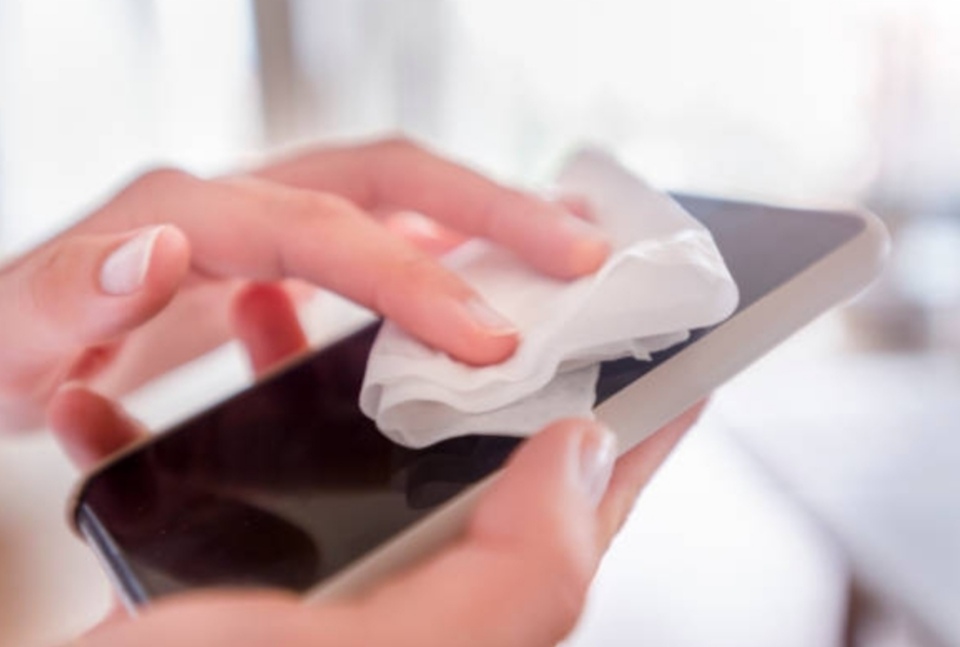Understanding the Importance of Cleaning Your Smartphone
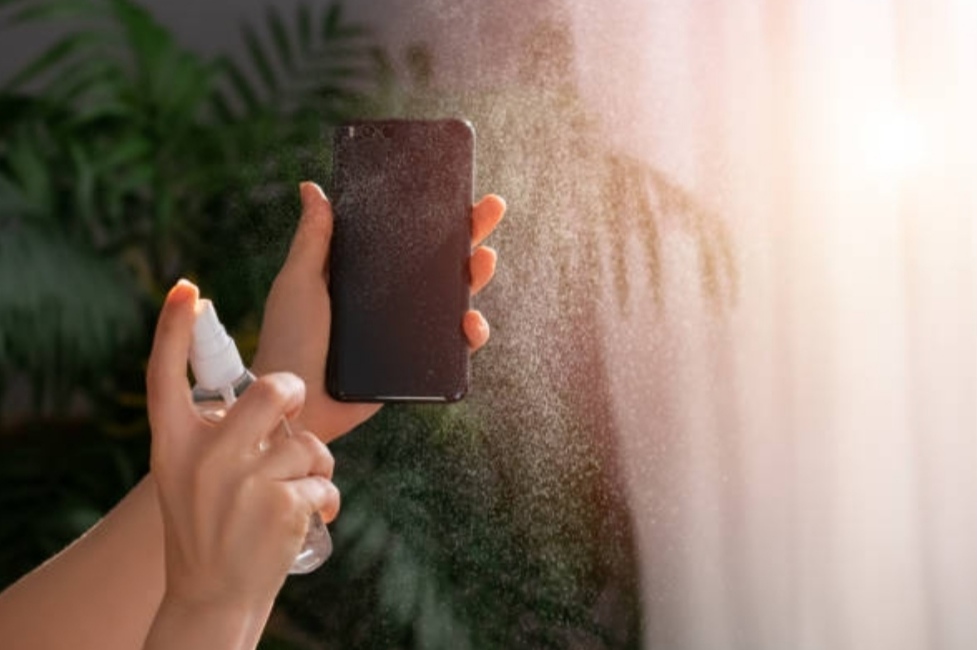
The Prevalence of Germs on Smartphones
Smartphones are among the dirtiest objects we touch daily.
Studies reveal that the average smartphone harbors 10 times more bacteria than a toilet seat.
This happens because we carry our phones everywhere—restaurants, public transportation, bathrooms—and rarely think about cleaning them.
When you touch your phone after handling dirty surfaces, you transfer germs, bacteria, and even viruses to the screen and body of the device.
These microorganisms thrive on the warmth of the phone, making it an ideal breeding ground.
Think about it: every time you touch your face after using your phone, you’re potentially exposing yourself to harmful pathogens.
In fact, research has shown that devices may carry bacteria such as E. coli and Streptococcus, which can cause severe illnesses.
Regular cleaning helps reduce these risks and ensures your smartphone stays germ-free.
In this guide, you’ll learn about how to clean smartphone safely.
Health Risks Associated with Dirty Devices
Dirty smartphones aren’t just gross—they can lead to serious health concerns.
Harmful bacteria and viruses lingering on your phone can cause skin infections, food poisoning, or respiratory illnesses.
This is especially dangerous during flu season or outbreaks of contagious diseases.
For individuals with compromised immune systems, these risks are even higher.
Frequent contact with a contaminated device can increase exposure to harmful microorganisms, leading to repeated illnesses.
Additionally, people often hold their phones close to their mouths during calls, increasing the chances of transferring germs from their devices into their respiratory system.
Poor hygiene practices, such as not washing hands before using a phone, only worsen the problem.
How to Clean Your Smartphone Safely
To avoid these health risks, it’s essential to know how to clean your smartphone safely.
Using appropriate cleaning techniques and tools ensures that your phone stays clean without risking damage to its components.
Benefits of Regular Cleaning
- Prevents Illness: A sanitized phone reduces exposure to harmful bacteria.
- Improves Longevity: Cleaning can prevent grime from damaging ports and screens.
- Promotes Hygiene: Encourages better overall cleanliness habits.
Maintaining a clean smartphone isn’t just about aesthetics—it’s about protecting your health and ensuring that your device continues to function optimally.
Start cleaning your devices regularly to minimize these risks and enjoy a healthier, more hygienic experience.
Take action today—start cleaning your smartphone safely using our recommended cleaning tools and products! Your health and peace of mind are worth it.
Preparing to Clean Your Smartphone
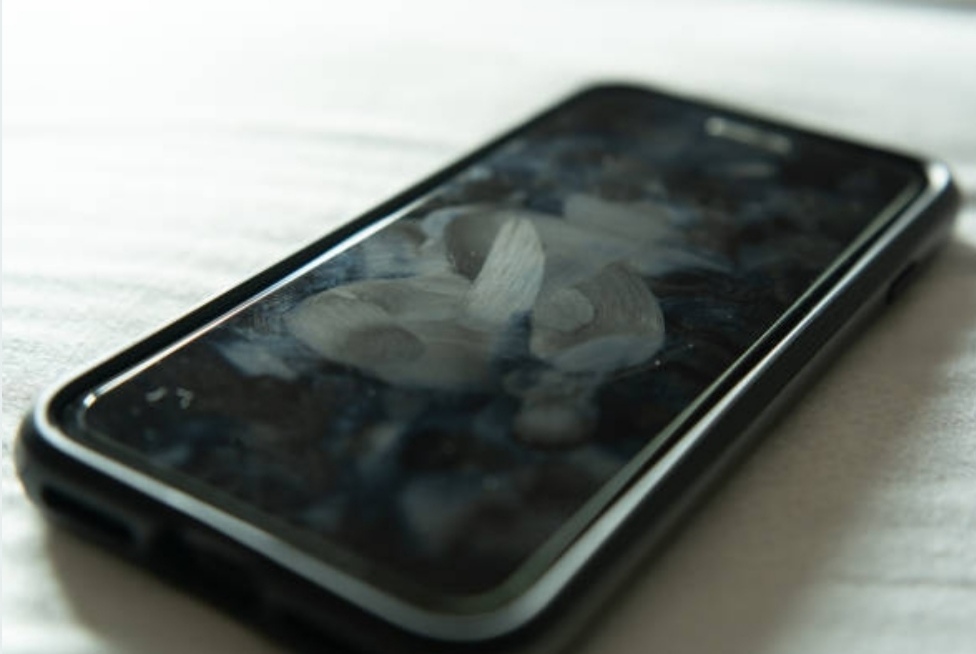
Powering Off and Unplugging Your Device
Before you start cleaning your smartphone, the first and most critical step is to power it off completely.
This is a precautionary measure to protect your device from short circuits or accidental damage caused by liquid cleaners.
Turning off your smartphone not only ensures safety but also allows you to clean every part of the device without interruptions from notifications or accidental touch inputs.
Make sure to unplug your phone from any chargers, headphones, or external devices. Cleaning your phone while it’s connected to a power source can increase the risk of electric shocks or damage.
Additionally, if your device has a removable battery, consider taking it out before cleaning.
This provides better access to the phone’s inner edges and reduces the chance of moisture affecting the internal components.
When learning how to clean your smartphone safely, starting with a powered-off and unplugged device ensures both safety and efficiency.
A simple yet often overlooked step like this can protect your device while preparing it for a thorough cleaning.
Removing the Case and Accessories
The next step in preparing to clean your smartphone is removing the case and any accessories, such as screen protectors, pop sockets, or styluses.
These items often accumulate dirt, grime, and bacteria, making them essential components to clean separately.
Begin by gently taking off the phone case. Inspect the case for visible dirt or debris, especially along the edges where grime tends to build up.
Cases made of silicone or hard plastic can often be cleaned with warm soapy water, but always check the manufacturer’s instructions to avoid damaging the material.
For screen protectors, consider replacing them if they are old, cracked, or excessively dirty. Cracks in screen protectors can harbor bacteria and make it difficult to clean the surface effectively.
Accessories such as earphones, charging cables, and styluses should also be cleaned using appropriate methods.
Wipe them down with a microfiber cloth and sanitize them with a small amount of isopropyl alcohol to remove germs.
Removing these components ensures that every part of your device is cleaned thoroughly, reducing the chances of leaving behind dirt or bacteria.
Remember, when it comes to keeping your gadgets germ-free, it’s not just about the phone itself—it’s about the accessories you use daily as well.
Don’t overlook the basics—power off your phone and remove accessories before cleaning. Use trusted cleaning tools to ensure your device stays safe and spotless.
Safe Cleaning Materials and Tools
Keeping your smartphone clean and germ-free requires using the right cleaning materials and tools.
This ensures the safety of your device while achieving a thorough clean.
Below, we’ll explore the best tools, materials, and cleaning solutions to help you understand how to clean your smartphone safely without causing damage.
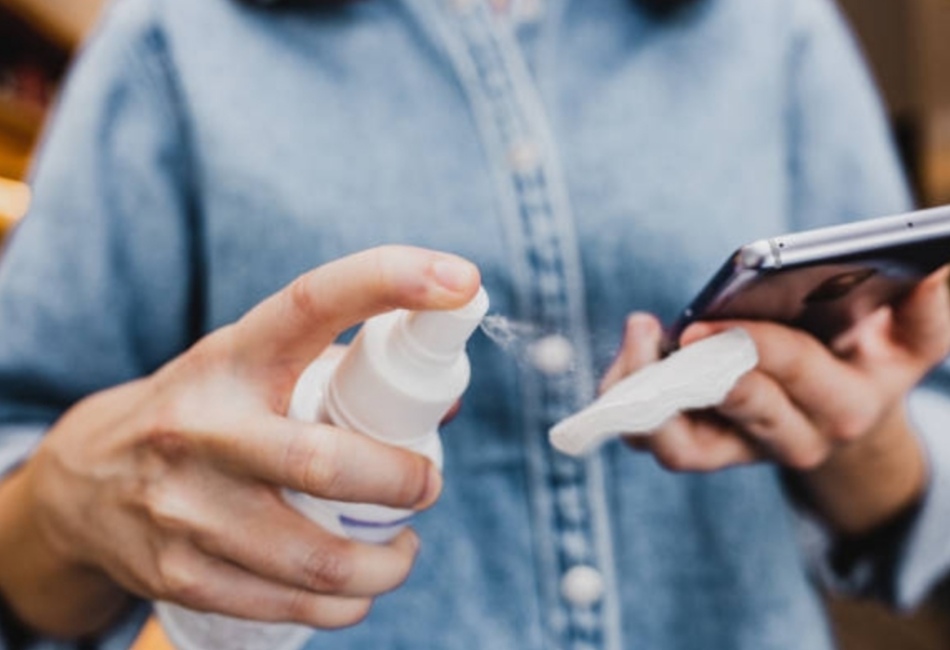
Microfiber Cloths – The Gentle Essential
A microfiber cloth is one of the safest and most effective tools for cleaning your smartphone.
Unlike paper towels or regular fabric, microfiber is designed to trap dust, dirt, and grease without scratching sensitive surfaces.
Using a microfiber cloth ensures your phone’s screen stays pristine, free of streaks and scratches.
To clean effectively, slightly dampen the cloth with water or an approved cleaning solution before wiping your device.
Always use gentle, circular motions to avoid applying too much pressure, which could damage the screen or internal components.
These cloths are reusable, eco-friendly, and widely available. They are perfect for cleaning screens, cameras, and even accessories like cases and chargers.
For better hygiene, wash your microfiber cloth regularly to remove accumulated dirt and germs.
70% Isopropyl Alcohol – A Proven Sanitizer
When it comes to killing germs, 70% isopropyl alcohol is the gold standard. It effectively eliminates bacteria and viruses while being safe for use on most smartphones.
Many manufacturers, including Apple and Samsung, recommend isopropyl alcohol-based solutions for cleaning devices.
To use, apply a small amount of the alcohol to a microfiber cloth—never directly onto the device. Gently wipe the screen, back, and sides of your phone.
Pay extra attention to frequently touched areas like the power button and volume controls.
Alcohol-based wipes, such as those designed for electronics, are also an excellent option for on-the-go cleaning.
Avoid using higher concentrations of alcohol, as they can evaporate too quickly and potentially damage the protective coatings on your screen.
Avoiding Harsh Chemicals and Abrasive Materials
Not all cleaning agents are safe for your smartphone. Harsh chemicals like bleach, ammonia, or hydrogen peroxide can strip your phone’s oleophobic (oil-resistant) coating, leaving the screen prone to smudges and scratches.
Abrasive materials like paper towels, tissues, or rough sponges can cause micro-scratches on the screen and body of the device.
Avoid directly spraying liquids onto your phone, as excess moisture can seep into ports and speakers, leading to potential water damage.
Stick to soft, lint-free materials and gentle cleaning solutions to protect your device’s longevity.
Pro Tip: When choosing cleaning solutions, look for products labeled as “safe for electronics” or “screen-friendly.” Check out our recommended cleaning kits to ensure you’re using safe and effective materials.
Other Safe Tools to Consider
- Compressed Air: Ideal for cleaning debris from small crevices like charging ports or headphone jacks. Use short bursts to avoid condensation.
- Cotton Swabs: Useful for cleaning hard-to-reach areas around buttons and ports. Dampen the tip slightly with isopropyl alcohol for added effectiveness.
- UV Sanitizers: These devices use ultraviolet light to kill germs without the need for liquids or chemicals. They are safe, effective, and perfect for regular sanitization.
Ensure Your Device’s Safety and Longevity!
Using the right tools is crucial for keeping your smartphone clean and safe.
Invest in high-quality cleaning supplies like microfiber cloths and alcohol-based solutions for optimal results. Discover our top-rated cleaning products today and keep your device in top condition!
Step-by-Step Guide to Cleaning Your Smartphone
Cleaning your smartphone properly is essential to maintain hygiene and ensure the device’s longevity.
This step-by-step guide will help you learn how to clean your smartphone safely while addressing every component of the device.
Follow these simple yet effective steps to achieve a spotless and germ-free phone.
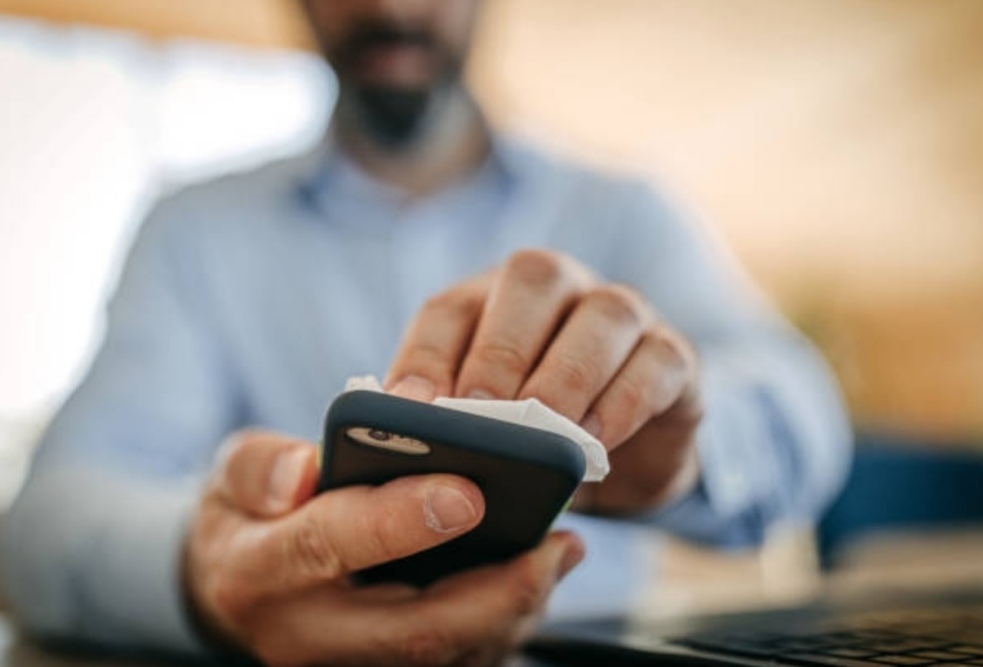
Wiping the Screen and Exterior Surfaces
The screen is the most touched and visible part of your smartphone, so cleaning it effectively is crucial.
Here’s how to clean the screen and other external surfaces without causing damage:
- Dampen a Microfiber Cloth: Lightly moisten a microfiber cloth with water or a 70% isopropyl alcohol solution. Ensure the cloth is damp, not wet, to prevent excess moisture from seeping into your phone.
- Use Gentle Circular Motions: Wipe the screen in gentle, circular motions to remove fingerprints, smudges, and dirt. Avoid pressing too hard, as this could damage the touchscreen functionality.
- Clean the Sides and Back: Use the same cloth to clean the phone’s sides and back. Pay special attention to areas near the buttons where dirt tends to accumulate.
- Avoid Direct Application of Liquids: Never spray cleaning solutions directly onto your phone, as the liquid can penetrate openings and damage internal components.
For best results, repeat this process daily or whenever the screen looks dirty. Microfiber cloths are reusable and perfect for maintaining a scratch-free surface.
Cleaning Ports and Openings
The charging port, headphone jack, and speaker grilles can accumulate dust and debris over time, affecting your phone’s functionality.
Cleaning these areas requires special care to prevent damage.
- Use Compressed Air: A can of compressed air is ideal for blowing dust and dirt out of tiny openings. Hold the can upright and spray short bursts into the ports to dislodge particles. Avoid prolonged sprays, as condensation might form.
- Employ a Soft-Bristled Brush: For stubborn debris, use a soft, dry brush designed for electronics. Gently brush around the edges of the ports to remove buildup.
- Avoid Sharp Objects: Never insert sharp objects like needles or toothpicks into ports, as they can damage connectors or push dirt further inside.
- Sanitize Carefully: If you need to sanitize these areas, lightly dampen a cotton swab with isopropyl alcohol and carefully clean the port’s exterior. Ensure the swab is not dripping.
Regularly checking and cleaning ports can extend your phone’s life and prevent charging or sound issues caused by debris.
Sanitizing the Case and Accessories
Your phone case and accessories are equally exposed to germs and dirt, so they should be cleaned regularly. Here’s how to do it effectively:
- Remove the Case: Before cleaning your phone, always take off the case. This allows you to clean both the phone and the case thoroughly.
- Wash Plastic or Silicone Cases: For plastic or silicone cases, use warm water and mild soap. Submerge the case in soapy water and gently scrub it with a soft cloth or sponge. Rinse it thoroughly and let it air dry completely before putting it back on your phone.
- Clean Fabric or Leather Cases: For fabric or leather cases, follow the manufacturer’s care instructions. Use a damp cloth with mild soap or a specialized cleaner for delicate materials.
- Disinfect Accessories: Cables, chargers, and headphones should be wiped with a cloth dampened with isopropyl alcohol to remove germs and dirt. Avoid applying excessive moisture to avoid electrical damage.
- Reassemble Your Device: Once the phone and case are completely dry, reassemble them.
Pro Tip: Consider using antimicrobial cases or screen protectors for added protection against bacteria. Explore antimicrobial phone cases for optimal hygiene.
Keep Your Smartphone Spotless and Germ-Free!
Cleaning your smartphone and accessories doesn’t have to be complicated.
By following these simple steps, you can ensure your device remains in pristine condition while reducing the spread of germs.
Start your cleaning routine today with our recommended cleaning kits and tools!
Maintaining Your Smartphone’s Cleanliness
Maintaining your smartphone’s cleanliness goes beyond occasional deep cleaning.
By adopting simple habits and using protective accessories, you can ensure your device stays hygienic and functions optimally over time.
Here’s how to keep your smartphone spotless and germ-free in the long run.
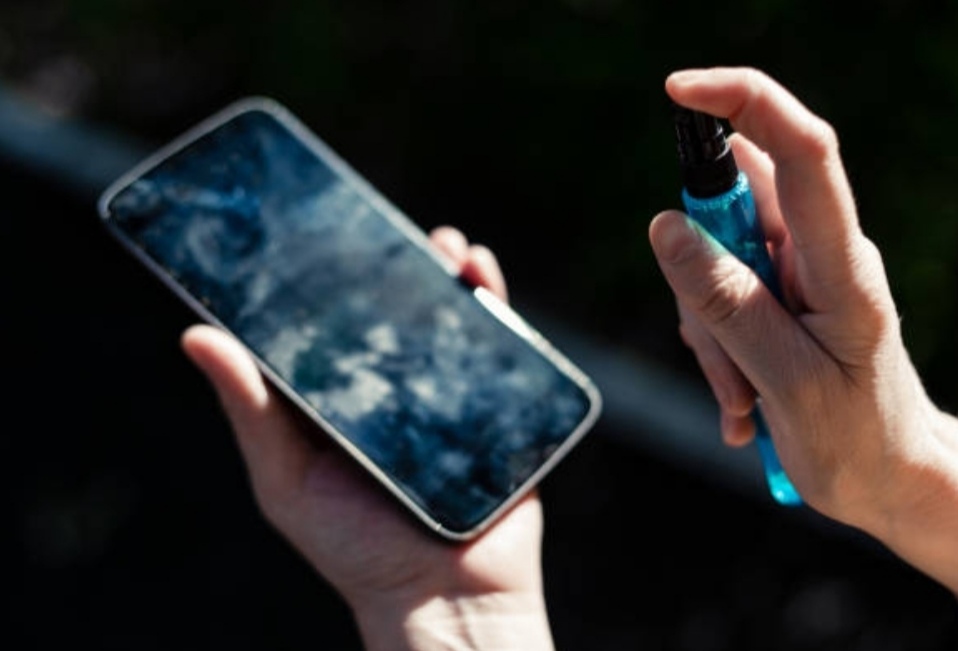
Establishing a Regular Cleaning Routine
Creating a consistent cleaning routine for your smartphone is essential for minimizing dirt, germs, and smudges. Here’s how you can establish an effective schedule:
- Daily Wipe-Down: At the end of each day, use a dry microfiber cloth to remove fingerprints, smudges, and dust from your screen and casing. This quick action prevents grime from building up over time.
- Weekly Deep Cleaning: Dedicate one day each week to thoroughly cleaning your smartphone. Use 70% isopropyl alcohol on a microfiber cloth to sanitize the screen and clean ports, buttons, and edges.
- Monthly Accessory Check: Don’t forget about your phone case, screen protector, and any attached accessories. Wash and sanitize these items monthly or more often if you use your phone in high-traffic areas or outdoors.
By sticking to this routine, you’ll reduce the spread of bacteria while extending the life of your device. If you’re wondering how to clean your smartphone safely, adhering to a regular routine is a significant first step.
Practicing Good Hygiene Habits
Your smartphone is often an extension of your hand, so practicing good personal hygiene is just as crucial as cleaning your device. Here are some habits to adopt:
- Wash Your Hands Frequently: Regular handwashing reduces the transfer of dirt, oils, and germs onto your smartphone. Aim to wash your hands before and after handling your phone, especially after eating or touching shared surfaces.
- Avoid Using Your Phone in Unhygienic Areas: Limit phone usage in places like bathrooms or public transport, where germs are more likely to spread.
- Refrain from Sharing Your Device: Sharing your smartphone can spread germs quickly. If you must share it, clean the screen and exterior surfaces afterward.
- Use Hands-Free Options: Opt for Bluetooth headsets or speaker mode during calls to minimize contact with your face and phone.
- Keep Food and Drinks Away: Avoid using your smartphone while eating or drinking to prevent spills, crumbs, and grease from contaminating your device.
Good hygiene habits not only protect your smartphone but also contribute to your overall health and well-being.
Using Protective Accessories
Investing in protective accessories can significantly reduce the accumulation of dirt, scratches, and germs on your smartphone. These additions act as a barrier, making maintenance easier and more effective:
- Antimicrobial Phone Cases: Choose a case with antimicrobial properties to reduce bacteria growth on your device’s surface. These cases are designed to keep germs at bay, adding an extra layer of protection.
- Tempered Glass Screen Protectors: A screen protector not only guards against scratches but is also easier to clean and replace than your actual screen. Look for options with oleophobic coatings to repel oils and fingerprints.
- Dust Plugs for Ports: Dust plugs are small, affordable accessories that fit into your charging and headphone ports, keeping dust and debris out. They are especially useful for those who work in dusty environments.
- Protective Pouches or Sleeves: When not in use, store your phone in a pouch or sleeve to shield it from dirt, scratches, and accidental spills.
Using these accessories is a proactive way to keep your smartphone looking and functioning like new. Browse high-quality protective accessories to find solutions that work for your device.
Keep Your Smartphone Clean and Protected for Years!
Taking small, consistent steps to maintain your smartphone’s cleanliness can save you time, money, and stress in the long run. Start by establishing a routine, practicing good hygiene, and investing in protective accessories. Don’t wait—explore our top-rated cleaning tools and protective gear today and enjoy a cleaner, more reliable smartphone experience!
Common Mistakes to Avoid When Cleaning Your Smartphone
While cleaning your smartphone is essential, certain mistakes can lead to unintended damage, reduced functionality, or even voided warranties.
By avoiding these common pitfalls, you can ensure your smartphone remains in excellent condition. Below are the key cleaning mistakes to steer clear of and why.
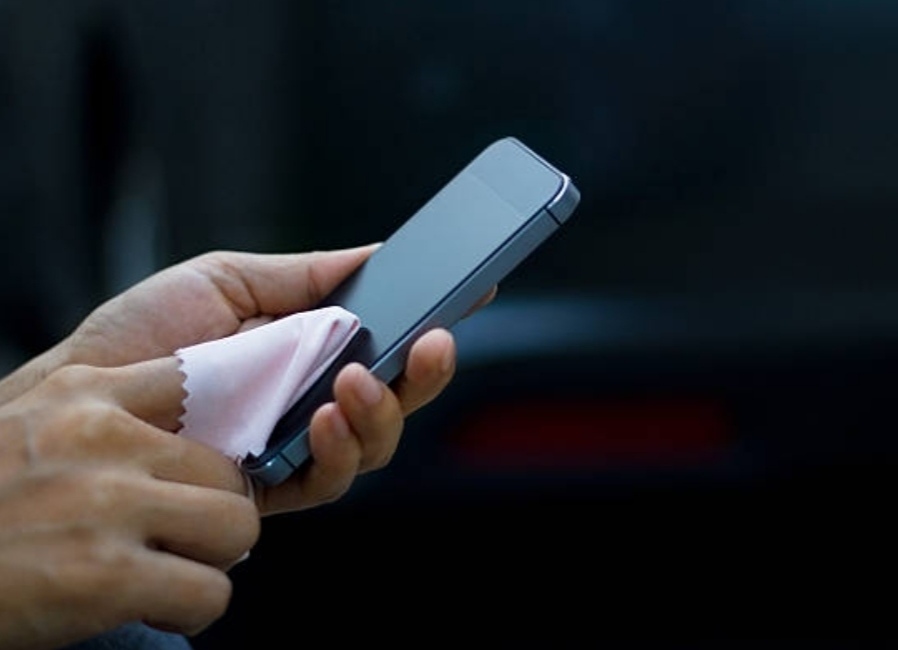
Using Excessive Moisture
Excess moisture is one of the most frequent errors people make when cleaning their smartphones.
Even though water is a universal solvent, it can harm your device when not used correctly.
- Why It’s Harmful: Smartphones have sensitive internal components that can be damaged by water intrusion. Even with water-resistant models, excess liquid can seep into ports and crevices, potentially causing corrosion or malfunction.
- How It Happens: This usually occurs when individuals soak a cloth in water or spray liquid cleaners directly onto their phones. Additionally, improper drying methods, like leaving residual moisture, increase the risk of damage.
- Safe Cleaning Practices: Always use a damp, not wet, microfiber cloth for cleaning. Wring out excess liquid before using the cloth, and ensure the surface is merely damp enough to remove dirt without dripping.
- Pro Tip: For stubborn stains or smudges, use a small amount of 70% isopropyl alcohol on a microfiber cloth instead of water. Alcohol evaporates quickly, reducing the risk of liquid-related damage.
Incorporating these steps into your cleaning routine is key when learning how to clean a smartphone safely without exposing it to unnecessary risk.
Applying Cleaners Directly to the Device
Directly spraying or applying cleaners to your smartphone is a serious mistake that many people overlook.
While it may seem convenient, it can lead to significant issues.
- Why It’s Risky: Spraying liquid cleaners directly onto your device increases the chances of liquid seeping into its buttons, ports, and seams. This can damage internal components, even if the phone has some degree of water resistance.
- Common Cleaners to Avoid: Household cleaning products like window cleaners, bleach, or multi-surface sprays often contain harsh chemicals that can strip protective coatings, such as the oleophobic layer on your smartphone screen.
- Proper Technique: Instead of applying cleaners directly, spray or dab a small amount onto a microfiber cloth. Gently wipe the surface of your device to ensure even coverage without oversaturating.
- Additional Caution: Be mindful of alternative products like baby wipes or generic disinfectant wipes. While some are safe, others may contain alcohol concentrations that are too high or abrasive substances that can scratch your screen.
By following these tips, you’ll better understand how to clean your smartphone safely without compromising its integrity.
Neglecting to Check Manufacturer Guidelines
Every smartphone manufacturer provides specific cleaning and care instructions for their devices, but many users neglect to review them.
Ignoring these guidelines can result in avoidable damage or warranty voidance.
- Why Manufacturer Guidelines Matter: Each smartphone model may have unique materials, coatings, or water-resistance ratings that dictate the appropriate cleaning methods. For instance, Apple advises against using certain cleaning products that could degrade the oleophobic coating on iPhones.
- Potential Consequences: Using unapproved methods or products could lead to physical damage or void your warranty, making repairs more costly if issues arise.
- How to Check Guidelines: Visit your manufacturer’s website or refer to the user manual for cleaning instructions. Search for terms like “cleaning and care” to find recommendations tailored to your device.
- Tips for Adherence: If the guidelines suggest avoiding alcohol-based cleaners, opt for alternative options like water-dampened cloths or cleaning kits approved by the manufacturer.
Understanding these guidelines ensures you clean your smartphone safely and maintain its longevity. Find official cleaning kits here to align with manufacturer-recommended practices.
Avoid These Mistakes and Protect Your Smartphone Today!
Cleaning your smartphone doesn’t have to be risky if you know what to avoid.
Stick to safe practices, use the right tools, and always check manufacturer recommendations. Ready to keep your smartphone spotless and damage-free?
Explore the best cleaning tools and accessories now to make the process effortless!
Cleaning Other Gadgets Safely
Beyond smartphones, our lives are filled with other gadgets that require regular cleaning for hygiene and optimal performance.
From tablets and laptops to wearable devices, understanding how to clean these gadgets properly is crucial.
Below, we provide detailed steps for cleaning other popular devices while incorporating best practices to avoid damage.
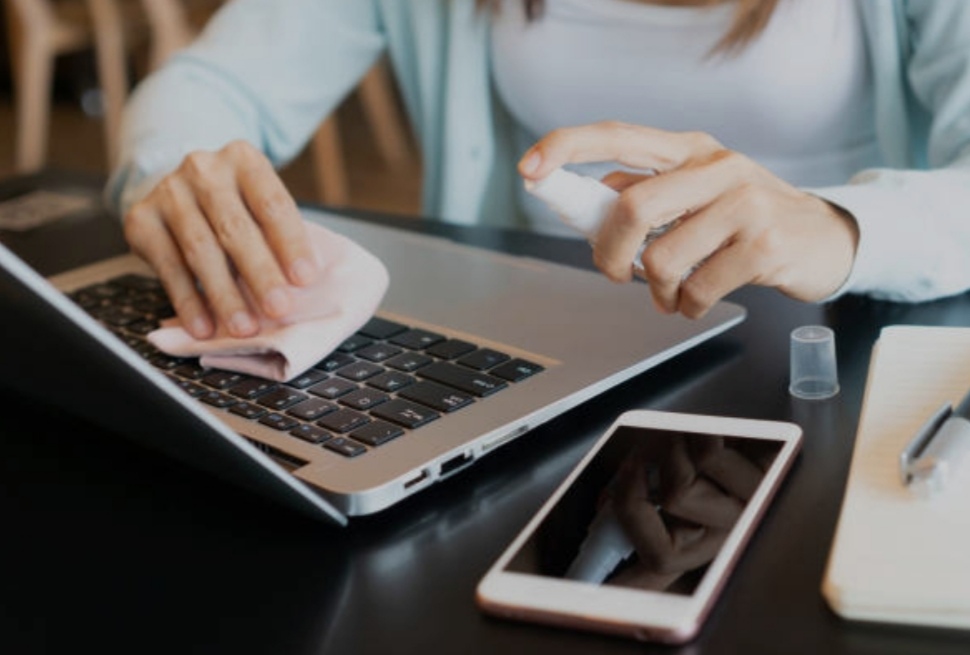
Cleaning Tablets and E-Readers
Tablets and e-readers often serve as portable, everyday tools for work, entertainment, or reading.
Over time, they accumulate dirt, smudges, and bacteria, especially on their touchscreens. Here’s how to clean them safely:
- Screen Cleaning:
- Use a soft microfiber cloth to gently remove smudges and fingerprints.
- For stubborn spots, slightly dampen the cloth with water or a 70% isopropyl alcohol solution. Avoid using harsh cleaning agents, as they can damage the screen’s protective coating.
- Pro Tip: Don’t press too hard while cleaning the screen, as this could cause scratches or screen damage.
- Cleaning the Ports and Openings:
- Use a compressed air canister or a dry, soft brush to clean the charging ports and headphone jacks.
- Avoid inserting sharp objects, as they can damage internal components.
- Maintaining the Back Cover and Buttons:
- Wipe the back cover with a slightly damp cloth. For plastic or aluminum surfaces, a mild soap solution can be effective.
- Carefully clean buttons using cotton swabs dipped in a minimal amount of isopropyl alcohol.
- Special Considerations:
- Always power off the device before cleaning.
- Check the manufacturer’s guidelines for cleaning instructions tailored to your specific device.
Cleaning your tablet or e-reader safely can extend its life and ensure it functions optimally.
How to Clean Laptops and Keyboards Safely
Laptops and keyboards are notorious for accumulating dirt, dust, and crumbs, especially if used during meals or in dusty environments.
Cleaning these devices requires extra care to avoid damaging sensitive components.
- Cleaning the Screen:
- Power off the laptop before cleaning.
- Use a screen-safe microfiber cloth to wipe away dust and smudges.
- Avoid spraying cleaners directly onto the screen; instead, lightly dampen the cloth with a water or alcohol solution.
- Keyboard Maintenance:
- Turn the laptop upside down and gently shake it to remove loose debris.
- Use a compressed air canister to blow dust out from between the keys.
- Wipe the keyboard with a disinfectant wipe or a cloth lightly dampened with isopropyl alcohol.
- Exterior Cleaning:
- For the laptop’s exterior, use a soft cloth to wipe away dirt and fingerprints.
- Be cautious with ventilation areas; use a brush to clean these without forcing dust deeper inside.
- Tips for Safety:
- Avoid using excessive moisture, as it can seep into internal components.
- Use tools like keyboard cleaning gels or brushes to reach difficult areas without causing damage.
By following these steps, you can keep your laptop and keyboard clean while ensuring functionality and durability.
Cleaning Wearable Devices
Wearable devices, such as smartwatches and fitness trackers, are in constant contact with your skin.
Sweat, dirt, and oils can accumulate on these gadgets, making regular cleaning essential for both hygiene and performance.
- Cleaning the Watch Face:
- Use a soft microfiber cloth to wipe the watch face. For water-resistant models, you can rinse the surface under lukewarm water but avoid using soap unless specified by the manufacturer.
- For tougher grime, dampen the cloth with a mixture of water and mild soap.
- Cleaning the Bands:
- Silicone Bands: Wash with warm water and mild soap, then pat dry with a clean cloth.
- Leather Bands: Use a leather conditioner or a damp cloth to gently clean the surface. Avoid soaking leather bands in water.
- Metal Bands: Wipe with a damp cloth and dry thoroughly to prevent rust or discoloration.
- Sanitizing Sensors:
- Wipe down sensors and charging contacts with a cotton swab dipped in isopropyl alcohol.
- Ensure the device is powered off and thoroughly dry before reattaching it to your wrist.
- Additional Tips:
- Avoid exposing your wearable device to harsh chemicals or abrasives.
- Regularly clean these gadgets to prevent skin irritation or damage caused by dirt and sweat buildup.
Keep All Your Gadgets Spotless and Safe!
Regular cleaning isn’t just for smartphones—it’s a necessity for all your gadgets.
By following these tips, you can maintain hygiene, extend the life of your devices, and enhance their performance.
Ready to upgrade your cleaning tools? Explore the best cleaning kits for your gadgets today and take the first step toward spotless, functional tech!
Frequently Asked Questions
As we dive deeper into maintaining the cleanliness of your devices, it’s common to have questions about the best methods, products, and safety tips.
In this section, we’ll address some of the most frequently asked questions about cleaning smartphones and other gadgets, ensuring you know exactly how to clean them safely and effectively.
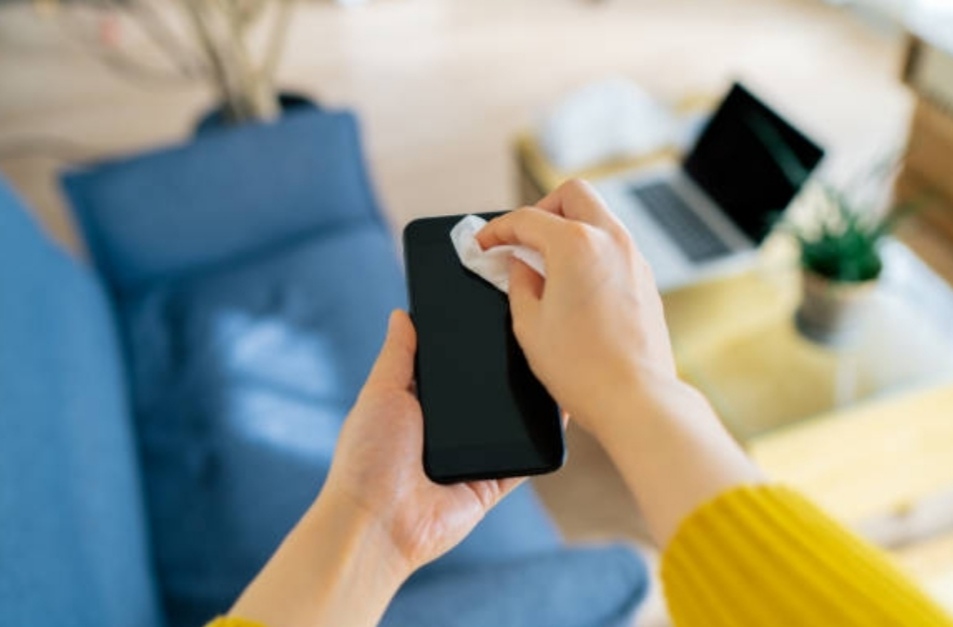
How Often Should I Clean My Smartphone?
Cleaning your smartphone should be part of your regular hygiene routine. Ideally, it’s best to clean your smartphone at least once a week, but this can vary depending on your usage and environment.
If you frequently use your phone in public places, eat while using it, or handle it with dirty hands, cleaning it more often—perhaps daily—is recommended.
Remember that your smartphone, like many other personal gadgets, comes into contact with a wide range of bacteria, viruses, and other contaminants.
To keep it hygienic, clean your smartphone safely using non-abrasive methods, as previously discussed.
Pro Tip: If you drop your phone in a public restroom or any high-risk environment, it’s a good idea to clean it thoroughly as soon as possible.
Can I Use Household Cleaners on My Smartphone?
While household cleaners may seem convenient, they can damage your smartphone’s screen or body.
Most household cleaners contain harsh chemicals, such as ammonia or bleach, that can strip away protective coatings like oleophobic (oil-repelling) and hydrophobic (water-repelling) layers.
The safest option is to use isopropyl alcohol (70% or higher) or disinfectant wipes specifically designed for electronics.
These products effectively sanitize your smartphone without damaging it.
Important Reminder: Never apply these cleaners directly to your phone. Instead, lightly dampen a microfiber cloth with the solution and gently wipe the device.
How to Clean Smartphone Safely Without Damaging the Screen?
One of the primary concerns when cleaning a smartphone is avoiding damage to the screen. Smartphone screens are delicate, so it’s essential to handle them with care.
To clean your screen safely:
- Power off your device before cleaning.
- Use a soft microfiber cloth to avoid scratching the surface.
- Avoid using excessive moisture; dampen the cloth lightly, never spraying any liquid directly on the screen.
- Use alcohol-based cleaners sparingly and only on the outer areas, not directly on sensitive areas like the touchscreen.
By following these steps, you can ensure that your screen stays scratch-free while still achieving a thorough clean.
Is It Safe to Clean My Smartphone With Water?
Water and electronics don’t always mix well.
While most modern smartphones are water-resistant to a degree, it’s still important to avoid using large amounts of water when cleaning.
Instead, always use a dampened microfiber cloth—not a soaked one. Excess moisture can seep into openings like the charging port, damaging the internal components.
Tip: When cleaning water-resistant devices, ensure the ports are dry before charging or using them again.
Can I Use a Disinfectant to Clean My Smartphone?
Yes, it’s safe to use disinfectant wipes to clean your smartphone, provided they’re alcohol-based and free from harmful chemicals like bleach.
Disinfectant wipes are effective in removing bacteria and viruses without causing damage.
Best Practice: Use wipes containing 70% isopropyl alcohol or wipes specifically designed for electronics. Always check the manufacturer’s guidelines to make sure these cleaning products won’t void your warranty.
Should I Clean My Smartphone’s Case?
Yes, it’s essential to clean your smartphone’s case regularly.
Your case comes into contact with various surfaces, collecting dirt, bacteria, and oils over time. To clean it:
- For plastic or silicone cases, wash them with mild soap and water.
- For leather cases, use a cleaner specifically designed for leather and avoid using excessive moisture.
- Metal cases can be wiped with a damp cloth and dried thoroughly.
Tip: A clean case can improve the lifespan of both your device and the case itself. Regularly cleaning your case helps prevent the buildup of grime that could transfer back onto your phone.
Can I Use Compressed Air to Clean My Smartphone?
Using compressed air can be helpful for cleaning dust and debris from areas that are hard to reach, such as the charging port or headphone jack.
However, it’s important to use the air cautiously.
Do not aim the air directly at your smartphone’s screen.
Always keep the nozzle a few inches away and blow gently to avoid pushing dirt further into the device.
Important Tip: Avoid using compressed air around the device’s internal components, as it could cause static or force dirt deeper into the phone.
How to Clean Smartphone Safely Without Voiding the Warranty?
When cleaning your smartphone, it’s essential to follow the manufacturer’s recommendations to avoid voiding the warranty.
Many manufacturers provide specific guidelines for safely cleaning your phone.
These instructions can usually be found in your user manual or on the manufacturer’s website.
Here are some general tips for cleaning your smartphone safely without risking the warranty:
- Use mild, alcohol-free cleaning solutions.
- Avoid using excessive moisture or harsh chemicals.
- Always power off your device before cleaning.
By following these tips, you can keep your device clean while ensuring you don’t inadvertently cause any harm that could void your warranty.
Keep Your Devices in Top Shape!
Don’t wait until your smartphone is covered in dirt and bacteria.
Regularly cleaning your phone ensures it not only looks great but works optimally, too!
If you’re unsure about the right cleaning products, be sure to check the manufacturer’s guidelines or consider investing in high-quality cleaning tools for all your gadgets.
Ready to clean your devices the right way? Take action now and keep your gadgets looking and performing like new!
Conclusion of Cleaning Your Smartphone
As we reach the end of this comprehensive guide on cleaning smartphones safely, it’s essential to recap the key practices that will help you keep your device in pristine condition while also promoting hygiene.
By following these safe cleaning practices, you can avoid potential damage to your smartphone, while also maintaining its appearance and functionality.
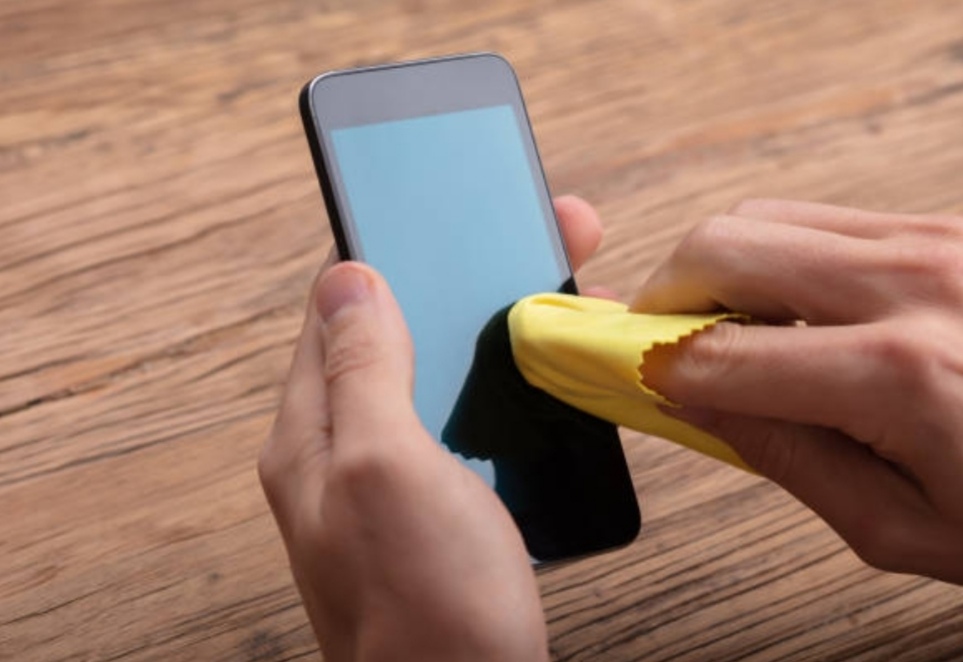
Recap of Safe Cleaning Practices
To clean your smartphone safely, it’s important to use the right methods and products to avoid damaging your device. Here’s a quick recap of the most effective and safe cleaning practices:
- Use a microfiber cloth: Always clean your screen and body with a soft microfiber cloth to avoid scratching the surface.
- Avoid excessive moisture: Only slightly dampen your cloth with water or cleaning solution, never apply liquid directly to your device.
- Disinfect with care: Use alcohol-based disinfectant wipes (preferably 70% isopropyl alcohol) for cleaning, but make sure they’re designed for electronics.
- Avoid harsh chemicals: Steer clear of household cleaners like bleach or ammonia, which can damage the device’s screen and protective layers.
- Power off before cleaning: Always turn off your phone before cleaning to avoid any electrical issues.
By following these steps, you can ensure your smartphone remains in excellent condition and free from harmful bacteria and dirt.
Regular cleaning is vital, not only for aesthetics but for maintaining a healthy environment around your device.
This helps prevent germs and viruses from spreading, especially since smartphones come into contact with our faces, hands, and various surfaces throughout the day.
Encouragement to Maintain Device Hygiene
Maintaining good hygiene for your smartphone is just as important as cleaning any other personal device.
Your smartphone is an everyday companion, and given the amount of time we spend touching and using it, it’s easy for germs, dirt, and bacteria to accumulate.
How to clean smartphone safely should be a routine part of your device care to ensure that your phone remains free of harmful pathogens and stays functional for years.
By incorporating regular cleaning into your routine, you’re not just ensuring your smartphone’s longevity, but you’re also promoting overall health and wellness.
For those with sensitive skin or allergies, regular cleaning helps reduce the buildup of oils, dust, and allergens that can affect your skin.
Final Thoughts on Device Hygiene
In today’s world, cleaning your smartphone and other devices properly is more important than ever.
With the ongoing risks posed by viruses and bacteria, ensuring that your smartphone is cleaned regularly with safe, effective methods is key.
By being proactive and taking the right steps, you are not only protecting your device but also protecting yourself and others.
Remember that safe cleaning goes beyond just aesthetics—it’s about maintaining functionality and ensuring hygiene.
Now that you know how to clean your smartphone safely, don’t forget to extend this practice to your other gadgets as well.
Tablets, laptops, and wearable devices all benefit from the same cleaning methods to ensure they remain free from dirt and germs.
Take action today by cleaning your smartphone the right way and keeping it sanitized and well-maintained.
If you’re unsure about cleaning products or techniques, be sure to check out recommended cleaning tools that are designed for smartphones and other electronics.
These products will ensure that you’re cleaning your devices in a way that’s safe, effective, and long-lasting.
Now is the time to take control of your device hygiene.
Keep your smartphone clean and safe by implementing these cleaning habits, and remember to make it a regular part of your device care routine.
Keep your devices looking brand new and feel confident that you’re maintaining both their health and yours.
You might also like :

